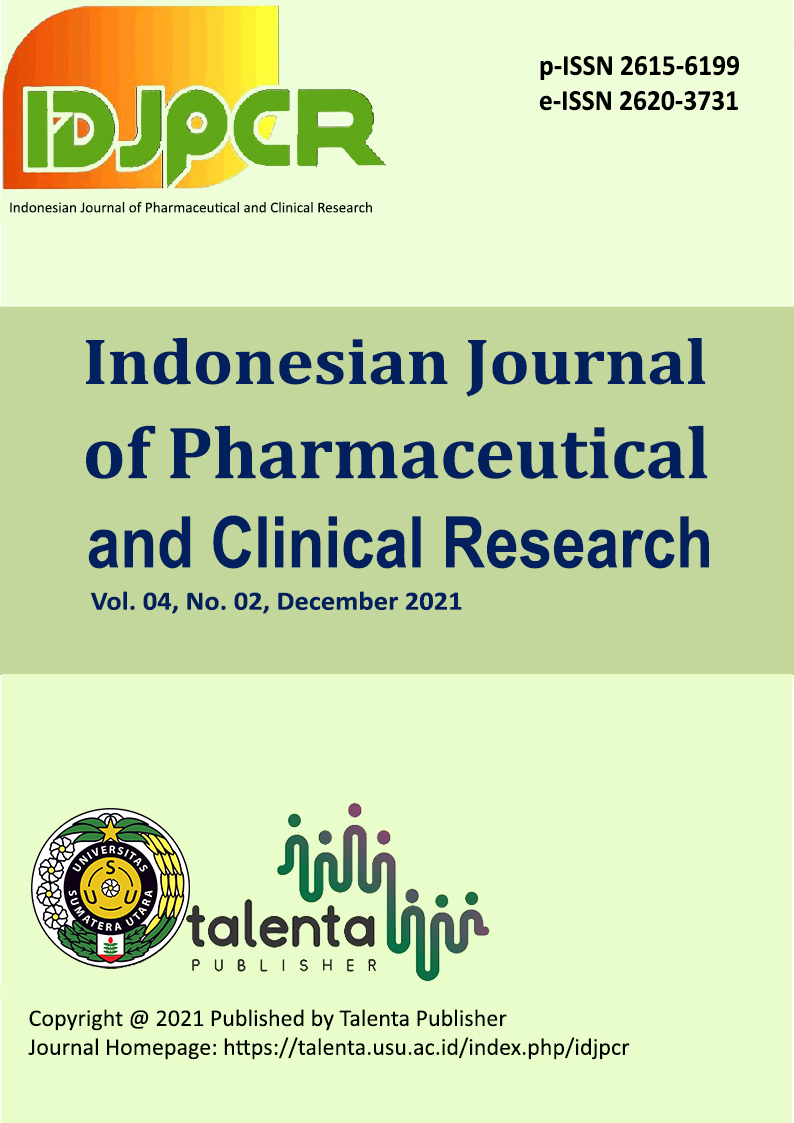Antibiotic Use in Cesarean Section and Hysterectomy Procedure: Qualitative and Quantitative Assessment
DOI:
https://doi.org/10.32734/idjpcr.v4i2.6235Keywords:
ATC-DDD index, antibiotic evaluation, antibiotic prophylaxis, obstetric and gynecologyAbstract
Antibiotic resistance is global issue and the incident is increasing with the use of unwise antibiotic. This study is to describe and evaluate appropriateness of antibiotic prophylaxis selection on Cesarean Section and Hysterectomy procedure. Purpose of study is to evaluate appropiateness of antibiotic selection on cesarean section and hysterectomy. A retrospective study was performed during September 2016 - January 2017 in Private Hospital, Semarang. Data were analized quantitatively using ATC-DDD methodology. Evaluation of antibiotic prophylaxis will be assessed based on The guideline of The American College of Obstetricians and Gynecologists (ACOG) : Antibiotic Prophylaxis for Gynecologic Procedures and The American Society of Health-System Pharmacists (ASHP) : Clinical Practice Guidelines for Antimicrobial Prophylaxis in Surgery. Overall, 90 of 95 patients were given antibiotic prophylaxis. The most frequently used antibiotics were ceftriaxone (69.51 DDD/Patient-days) and ceftazidime (14.95 DDD/Patient-days). Appropriate antibiotic selection based on the guidelines for cesarean section procedure was 1.75% and 6.1% for hysterectomy procedure. The use of antibiotic prophylaxis on cesarean section and hysterectomy procedure was very high and less appropriate in the selection. Almost patient received third-generation cephalosporin instead of first-generation cephalosporin such as cefazolin. cefazolin is more effective and narrow spectrum for infection-causing bacteria of these procedures.
Downloads
References
AphA. (2013). Drug Information Handbook a Comprehensive Resource for All Clinicians and Health-Care Professionals 22th Editions. Ohio, Lexi-comp.
Bratzler, D.W., and Houck, P.M. (2004). Antimicrobial Prophylaxis for Surgery: an Advisory Statement from the National Surgical Infection Prevention Project. Clinical Infectious Diseases, 38: pp.1706-1715.
Clifford, V., and Daley, A. (2012). Antibiotic Prophylaxis in Obstetric and Gynaecological a Procedures: a Review. Australian and New Zealand Journal of Obstetrics and Gynaecology, 52: pp.412-419.
Dhar, H., Al-Busaidi, I., Rathi, B., Nirme, E.A., Sachdeva, V., and Hamdi, I. (2014). A Study of Post-Caesarean Section Wound Infections in a Regional Referral Hospital, Oman. SQU
Jyothi, S.M., Vyas, N., Pratap, K., and Asha, K. (2010). Antibiotic Prophylaxis for Hysterectomy and Cesarean Section: Amoxicillin-Clavulanic Acid versus Cefazolin. Journal Obstetric and Gynecology Indian, 60(5): pp.419-423.
Kamat, A.A., Brancazio L., and Gibson, M. (2000). Wound Infection in Gynecologic Surgery. Infectious Diseases in Obstetrics and Gynecology, 8: pp.230-234.
Kusaba, T. (2009). Safety and Efficacy of Cefazolin Sodium in the Management of Bacteria Infection and in Surgical Prophylaxis. Clinical Medicine: Therapeutics, 1: pp.1607-1615.
Lachiewicz, M.P., Moulton, L.J., and Jaiyeoba, O. (2015). Infection Prevention and Evaluation of Fever after Laparoscopic Hysterectomy. Journal of Society of Laparoendoscopic Surgeons, 19: pp.1-7.
Mahendra, A.D., Tirtodihardjo, K., and Kusuma, I.K.D. (2016). The Pattern of Bacteria and Its Resistance on Adult Sepsis Patient at Dr. Moewardi General Hospital, Indonesia. Archieve of Clinical Microbiology, 7: pp.1-6.
Manyahi, J., Matee, M.I., Majigo, M., Moyo, Mshana, S.E., and Lyamuya, E.F. (2014). Predominance of Multi-Drug Resistance Bacterial Pathogens Causing Surgical Site Infection in Muhimbili National Hospital, Tanzania, BMC Research Notes, 7: pp.1-7.
Phoolcharoen, N., Nilgate, S., Rattanapuntamanee, O., Limpongsanurak, S., and Chaithongwongwatthana, S. (2012). A Randomized Controlled Trial Comparing Ceftriaxon with Cefazolin for Antibiotic Prophylaxis in Abdominal Hysterectomy. International Journal of Gynecology and Obstetrics, 119: pp.111-113.
Pop-Vicas, A., Johnson, S., Safdar, N. (2017). Should Cefazolin Be the First-line Antimicrobial Prophylaxis Choice in Patients Undergoing Hysterectomy? A Systematic Review and Meta-analysis, Open Forum Infectious Diseases, 4(1): pp.S650.
Radji, M., and Fauziah, A.N. (2011). Antibiotic Sensitivity Pattern of Bacterial Pathogens in The Intensive Care Unit of Fatmawati Hospital, Indonesia. Asian Pasific Journal of Tropical Biomedicine, 1: pp.39-42.
Schalkwyk, J.V, Eyk, N.V. (2010). Antibiotic Prophylaxis in Obstetric Procedures. SOGC Clinical Practice Guideline. Journal of Obstetrics and Gynecology Canada, pp.878-884.
Smaill, F.M., Gyte, G.M.L. (2010). Antibiotic Prophylaxis Versus no Prophylaxis for Preventing Infection after Cesarean Section. Cochrane Database of Systematic Reviews, pp.1-176.
Steinberg, J.P., Braun, B.I.B., Hellinger, W.C., Kusek ,I., Bozikis, M.R., and Bush, A.J. (2009). Timing Antimicrobial Prophylaxis and the Risk of Surgical Site Infections. Annals of Surgery, 1: pp.10-16.
Stiver, H.G., Binns, B.O., and Brunham, R.C. (1990). Randomized, Double-Blind Comparison of the Effecacies, Costs, and Vaginal Flora Alteractions with Single-Dose Ceftriaxon and Multidose Cefazolin Prophylaxis in Vaginal Hysterectomy. Antimicrobial Agents and Chemotherapy, 34: pp.1194-1197.
Sudarmono, P. (2013). Bacteria Fight Back, Also in Indonesia!. Acta Medica Indonesiana-The Indonesian Journal of Internal Medicine, 45: pp.1-2.
Tanos, V., and Rojansky, N. (1994). Prophylaxis Antibiotics in Abdominal Hysterectomy. Journal of The American College of Surgeons, 179: pp.593-600.
The American Academy of Family Physicians. Antibiotic Prophylaxis for Gynecologic Procedures. American Family Physician, 64: pp.676-678.
The American College of Obstetricians and Gynecologists. (2009). ACOG Practice Bulletin No. 104: Antibiotic Prophylaxis for Gynecologic Procedures. Obstetrics & Gynecology, 113: pp.1180-1189.
Tita, A.T., Owen, J., Stamm, A.M., Grimes, A., Hauth, J.C., and Andrews, W.W. (2008). Impact of Extended-Spectrum Antibiotic Prophylaxis on Incidence of Postcesarean Surgical Wound Infection. American Journal of Obsterics, 3: pp.303.e1-303.e3.
Weinstein, J.W., Roe, M., Towns, M., Sanders, L., and Thorpe, J.J., and Corey, G.R. (1996). Resistant Enterococci: A Prospective Study of Prevalence, Incidence, and Factors Associated with Colonization in A University Hospital. Infection Control Hospital Epidemiology, 17: pp.36–41.
Downloads
Published
How to Cite
Issue
Section
License
Copyright (c) 2021 Indonesian Journal of Pharmaceutical and Clinical Research

This work is licensed under a Creative Commons Attribution-ShareAlike 4.0 International License.
The Authors submitting a manuscript do so on the understanding that if accepted for publication, copyright of the article shall be assigned to Indonesian Journal of Pharmaceutical and Clinical Research (IDJPCR) and Faculty of Pharmacy as well as TALENTA Publisher Universitas Sumatera Utara as publisher of the journal.
Copyright encompasses exclusive rights to reproduce and deliver the article in all form and media. The reproduction of any part of this journal, its storage in databases and its transmission by any form or media, will be allowed only with a written permission from Indonesian Journal of Pharmaceutical and Clinical Research (IDJPCR).
The Copyright Transfer Form can be downloaded here.
The copyright form should be signed originally and sent to the Editorial Office in the form of original mail or scanned document.









